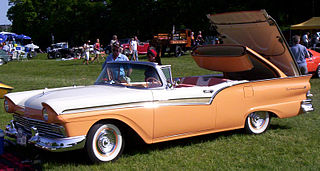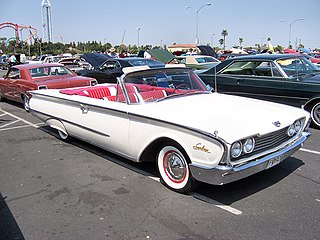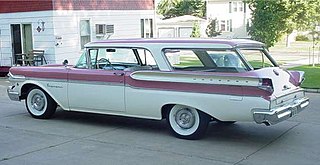
The Ford Thunderbird is a personal luxury car manufactured and marketed by Ford Motor Company from model years 1955 to 2005, across 11 generations. Introduced as a two-seat convertible, the Thunderbird was offered variously as a four-seat hardtop coupe, four-seat convertible, five-seat convertible and hardtop, four-door pillared hardtop sedan, six-passenger hardtop coupe, and five-passenger pillared coupe, with the final generation designed again as a two-seat convertible.

The Ford Galaxie is a car that was marketed by Ford in North America from the 1959 to 1974 model years. Deriving its nameplate from a marketing tie-in with the excitement surrounding the Space Race, the Galaxie was offered as a sedan within the full-size Ford range throughout its production run. In the full-size segment, the model line competed against the Chevrolet Impala and Dodge Polara.

The Chevrolet Bel Air is a full-size car produced by Chevrolet for the 1950–1981 model years. Initially, only the two-door hardtops in the Chevrolet model range were designated with the Bel Air name from 1950 to 1952. With the 1953 model year, the Bel Air name was changed from a designation for a unique body shape to a premium level of trim applied across a number of body styles. The Bel Air continued with various other trim level designations, and it had gone from a mid-level trim car to a budget fleet sedan when U.S. production ceased in 1975. Production continued in Canada, for its home market only, through the 1981 model year.

The Mercury Cougar is a series of automobiles that was sold by Mercury from 1967 to 2002. The model line is a diverse series of vehicles; though the Cougar nameplate is most commonly associated with two-door coupes, at various stages in its production, the model also was offered as a convertible and a hatchback. During its production as the mid-size Mercury line, the Cougar was also offered as a four-door sedan and five-door station wagon.

The Ford LTD is a range of automobiles manufactured by Ford for the 1965 to 1986 model years. Introduced as the highest trim level of the full-size Ford model range, the LTD moved the Ford range upmarket, offering options and features previously reserved for Mercury and Lincoln vehicles. For much of its production life, the LTD competed against the Chevrolet Caprice ; the Mercury Marquis served as its divisional counterpart from 1967 until 1986.

The Mercury Turnpike Cruiser is a series of automobiles that were produced by the Mercury division of Ford for the 1957 and 1958 model years. Named to commemorate the creation of the Interstate Highway System, the Turnpike Cruiser was marketed as the flagship Mercury model line, slotted above the Montclair when Mercury was positioned upmarket to luxury status when Edsel was introduced in 1958.

The Mercury Montclair is a series of full-size sedans that were manufactured and marketed over five generations by the Mercury division of Ford. The nameplate was used by the division twice, from the 1955 to the 1960 model years and from the 1964 to the 1968 model years. The model was offered as two-door and four-door hardtops, four-door pillared sedan, and a two-door convertible.

The Ford Fairlane is an automobile model that was sold between the 1955 and 1970 model years by Ford in North America. Taking its name from the Dearborn, Michigan estate of Henry Ford, the Fairlane nameplate was used for seven different generations of vehicles. Through its production, the model line would be marketed in a wide variety of body styles, including two-door and four-door sedans, two-door and four-door hardtops, station wagons, and both traditional and retractable-hardtop convertibles.

The Mercury Marquis is a model line of automobiles marketed by Mercury from 1967 to 1986. Deriving its name from a title of French nobility, the Marquis was introduced as the divisional counterpart of the Ford LTD; four generations of the two model lines were paired through rebranding. Initially slotted as the flagship Mercury full-size range, the Marquis would serve as the basis for the later Mercury Grand Marquis.

The 1957 Chevrolet is a car that was introduced by Chevrolet in September 1956 for the 1957 model year. It was available in three series models: the upscale Bel Air, the mid-range Two-Ten, and the One-Fifty. A two-door station wagon, the Nomad, was produced as a Bel Air model. An upscale trim option called the Delray was available for Two-Ten 2-door sedans. It is a popular and sought after classic car. These vehicles are often restored to their original condition and sometimes modified. The car's image has been frequently used in toys, graphics, music, movies, and television. The '57 Chevy, as it is often known, is an auto icon.

The DeSoto Adventurer is a full-sized automobile that was produced by DeSoto from 1956 through the 1961 model year. Introduced as a four-seat high-performance sports coupe concept car, the Adventurer ended up being DeSoto's special, limited-production, high-performance model, similar to the more luxurious and exclusive "letter series" Chrysler 300 and Chrysler Saratoga.

The Ford Falcon is a model line of cars that was produced by Ford from the 1960 to 1970 model years. Though preceded by the Rambler American, the Falcon was the first compact car marketed by the Big Three American manufacturers.

The Ford line of cars was again refreshed for 1952, although remaining similar to the all-new 1949 Fords. This time, curved one-piece windshield glass joined a new "Mileage Maker" straight-6 engine with 101 hp. The 226 CID (3.7 L) L-head straight-6 was replaced by an overhead valve 215 CID (3.5 L) Mileage Maker with 101 hp (75 kW), while the old 239 CID (3.9 L) Flathead V8 remained with 110 hp (82 kW). This design would continue through the 1954 model year, with an updated design offered in 1955.

The 1955 Ford is an automobile which was produced by Ford in the United States for the 1955 model year and, in revised form, for the 1956 model year. A new design would be offered in 1957.

The mainstream Ford line of cars grew substantially larger for 1957, a model which lasted through 1959. The Crown Victoria with its flashy chrome "basket handle" was no more, and the acrylic glass-roofed Crown Victoria Skyliner was replaced by a new model, the retracting-roof hardtop Skyliner.

Leading into the 1950s, Ford, along with many other top of the market car manufacturers were capitalizing on the post war boom. Many new advancements in technology and products were being developed during this time that allowed for cars going into the future to have features never seen before or features that were not normal until now. The automatic window, for example, was a new feature that made Americans see their current cars as outdated and technologically behind. The 1960s were one of the best eras for the production of cars, as the war between Ford and Chevrolet heated up and produced some of the most classic and recognizable cars in America still to this day.

The Mercury Monterey is a series of full-size cars that were manufactured and marketed by the Mercury division of Ford from 1950 to 1974. Deriving its name from Monterey Bay, the initial Mercury Monterey served as the top-of-the-line two-door sedan model for 1950 and 1951 to compete with the hardtop models of Oldsmobile and Buick. It came with a vinyl roof covering, upgraded upholstery, and other features. The hardtop was introduced for 1952. During its production, the Monterey would be offered in multiple body styles, ranging from coupes, convertibles, sedans, hardtops, and station wagons.

The Mercury Voyager is a station wagon that was sold by the Mercury division of Ford for the 1957 and 1958 model years. For the 1957 model year, Mercury created a model range of station wagons distinct from sedans, following Ford. The Voyager served as the mid-range offering, slotted above the base-trim Mercury Commuter, with the woodgrained Colony Park serving as the top-range offering.

The third generation of the Ford Thunderbird is a personal luxury car produced by Ford for the 1961 to 1963 model years. It featured new and much sleeker styling than the second generation models. Sales were strong, if not quite up to record-breaking 1960, at 73,051 including 10,516 convertibles. A new, larger 390 cu in (6.4 L) FE-series V8 was the only engine available. The Thunderbird was 1961's Indianapolis 500 pace car, and featured prominently in US President John F. Kennedy's inaugural parade, probably aided by the appointment of Ford executive Robert McNamara as Secretary of Defense.

The sixth generation of the Ford Thunderbird is a large personal luxury coupe that was produced by Ford for the 1972 to 1976 model years. A sibling of the Continental Mark IV, this generation of the Thunderbird was the largest ever produced; weighing in at over 5,000 pounds (2,268 kg), they are also the heaviest coupes ever produced by Ford.


























